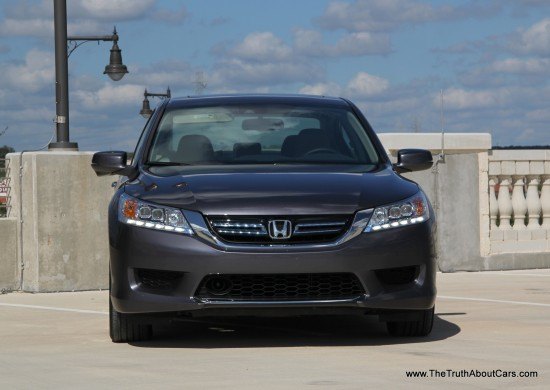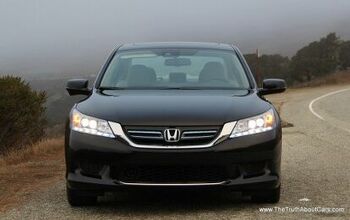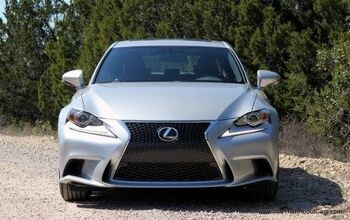First Drive Review: 2014 Honda Accord Hybrid (With Video)

As of October, the most fuel-efficient mid-sized sedan in America is the Honda Accord. Or so Honda says. After all, Ford has been trumpeting a matching 47 MPG combined from their Fusion. Who is right? And more importantly, can the Accord get Honda back into the hybrid game after having lost the initial hybrid battles with their maligned Integrated Motor Assist system? Honda invited us to sample the 2014 Accord Hybrid as well as a smorgasbord of competitive products to find out.
Exterior
I have always been a fan of “elegant and restrained” styling which explains my love for the first generation Lexus LS. That describes the 2014 Accord to a tee. Like the regular Accord, the hybrid is devoid of sharp creases, dramatic swooshes, edgy grilles or anything controversial. This is a slightly different take than the Accord Plug-in which swaps the standard Accord bumper for a bumper with a slightly awkward gaping maw. In fact, the only thing to show that something green this way comes are some blue grille inserts and LED headlamps on the top-level Touring model.
This means the Accord and the Mercedes E-Class are about the only sedans left that sport a low beltline and large greenhouse. Opinions on this style decision range from boring to practical and I fall on the latter. I think the Ford Fusion is more attractive but the Hyundai Sonata’s dramatic style hasn’t aged as well as its Kia cousin’s more angular duds. The Camry failed to move my soul when it was new and it hasn’t changed much over the years. This places the Accord tying with the Optima for second place.
Interior
Despite sporting an all-new interior in 2013, you’d be hard pressed to identify what changed over the last generation Accord unless you owned one. Instead of radical design buyers will find incremental improvements and high quality plastics. The dash is still dominated by a double-bump style dashboard with the second binnacle housing a standard 8-inch infotainment display. With manufacturers moving toward slimmer dash designs the Accord’s remains tall and large. For hybrid duty Honda swiped the Plug-in’s tweaked instrument cluster with a large analogue speedometer, no tachometer, LED gauges for battery, fuel and a power meter. Everything else is displayed via a full-color circular LCD set inside the speedometer.
Front seat comfort is excellent in the accord with thickly padded ergonomically designed front seats. There isn’t much bolstering (as you would expect from a family hauler) so larger drivers and passengers shouldn’t have a problem finding a comfortable seating position. The product planners wisely fitted adjustable lumbar support and a 10-way power seats to all trims.
Speaking of trim levels, in most ways (with the exception of that driver’s seat), the Accord EX serves as the “feature content” base for the hybrid. This means you’ll find dual-zone climate control, tilt/telescoping steering wheel, standard Bluetooth, a backup camera, keyless entry/go and active noise cancellation.
Thanks to a wheelbase stretch in 2013, the Accord hybrid sports 1.3 inches more legroom than the last Accord and is finally class competitive with essentially the same amount of room as the Fusion and Camry and a few inches more than the Koreans. The Accord’s upright profile means getting in and out of those rear seats is easier than the low-roofline competition and it also allows the seating position to be more upright. Honda’s sales pitch about the low beltline is that it improves visibility for kids riding in the back, I’m inclined to believe them. As with most hybrids, there’s a trunk penalty to be paid but thanks to energy dense Lithium-ion cells the Accord only drops 3 cubic feet to 12.7 and I had no problem jamming six 24-inch roller bags in the trunk. Honda nixed the folding rear seats, a feature that the competition has managed to preserve.
Infotainment, Gadgets and Pricing
Base Accords use physical buttons to control the standard 8-inch infotainment system and sport 6 speakers with 160 watts behind them. Honda wouldn’t comment on the expected model split of the Accord, but I suspect that most shoppers will opt for the mid-level EX-L which adds a subwoofer, 360 watt amp, and adds a touchscreen for audio system controls. The dual-screen design struck me as half-baked when I first sampled it in the regular 2013 Accord and although I have warmed up to it a bit, I think it could still use a few minutes in the oven if you opt for the navigation equipped Touring model.
Honda’s concept was to move all the audio functions to the touchscreen thereby freeing the upper screen for some other use like the trip computer or navigation screen. The trouble is the lower screen simply selects sources and provides track forward/backward buttons meaning you still have to use the upper screen to change playlists or search for tracks. That minor complaint aside, the system is very intuitive and responsive. Honda’s improved iDevice and USB integration is standard fare on all models and easily ties with the best in this segment.
Starting at $29,155, the base Accord Hybrid is the most expensive mid-sized hybrid sedan by a decent margin especially when you look at the $25,650 starting price on the Hyundai Sonata Hybrid. However, the Accord Hybrid delivers a high level of standard equipment including standard Pandora smartphone app integration and Honda’s Lane Watch system. Lane watch still strikes me as a little gimmicky since the Accord has such small blind spots and the best outward visibility in the segment already. Instead of stand alone options Honda offers just three trim levels. The next step is the $31,905 EX-L model which adds leather seats, a leather steering wheel, upgraded audio system with two LCD screens, memory driver’s seat, power passenger seat, moonroof, a camera based collision warning system and lane departure warning. While the base model is a little more expensive than cross-shops, the EX-L becomes a decent value compared to comparably equipped competitive hybrids.
Working your way up to the top-of-the-line $34,905 Touring model the Accord is no longer the most expensive in the class, that award goes to the $37,200 loaded fusion. At this price the Accord is less of a bargain compared to the competition, although you do get full LED headlamps and an adaptive cruise control system. In comparison the Camry spans from $26,140 to $32,015, the Sonata from $25,650 to $32,395, Optima from $25,900 to $31,950 and the Fusion from $27,200 to $37,200. How about the Prius? Glad you asked. The Prius that is most comparable to the base Accord Hybrid is $26,970 and comparably equipped to the Accord Touring is $35,135.
Drivetrain
Being the drivetrain geek that I am, what’s under the hood of the Accord hybrid is more exciting than the Corvette Stingray. Seriously. Why? Because this car doesn’t have a transmission in the traditional sense. Say what? Let’s start at the beginning. The last time Honda tried selling an Accord hybrid, they jammed a 16 HP motor between a V6 and a 5-speed automatic. The result was 25MPG combined. The 2014 hybrid system shares absolutely nothing with the old system. No parts. No design themes. Nothing.
Things start out with the same 2.0L four-cylinder engine used in the Accord plug-in. The small engine is 10% more efficient than Honda’s “normal” 2.0L engine thanks to a modified Atkinson cycle, an electric water pump, cooled exhaust gas return system, and electric valve timing with a variable cam profile. The engine produces 141 horsepower on its own at 6,200 RPM and, thanks to the fancy valvetrain, 122 lb-ft from 3,500-6,000 RPM.
The engine is connected directly to a motor/generator that is capable of generating approximately 141 horsepower. (Honda won’t release details on certain drivetrain internals so that’s an educated guess.) Next we have a 166 horsepower, 226 lb-ft motor that is connected to the front wheels via a fixed gear ratio. Under 44 miles per hour, this is all you need to know about the system. The 166 horsepower motor powers the car alone, drawing power from either a 1.3 kWh lithium-ion battery pack, or the first motor/generator. Over 44 miles per hour, the system chooses one of two modes depending on what is most efficient at the time. The system can engage a clutch pack to directly connect the two motor/generator units together allowing engine power to flow directly to the wheels via that fixed gear ratio. (Check out the diagram below.)
Pay careful attention to that. I said fixed gear ratio. When the Accord Hybrid engages the clutch to allow the engine to power the wheels directly (mechanically), power is flowing via a single fixed ratio gear set. The fixed gear improves efficiency at highway speeds, reduces weight vs a multi-speed unit and is the reason the system must use in serial hybrid mode below 44 mph. There is another side effect at play here as well: below 44 MPH, the system’s maximum power output is 166 horsepower. The 196 combined ponies don’t start prancing until that clutch engages.
So why does Honda call it an eCVT? Because that fits on a sales sheet bullet point and the full explanation doesn’t. Also, a serial hybrid can be thought of as a CVT because there is an infinite and non-linear relationship between the engine input and the motor output in the transaxle.
Drive
Let’s start off with the most important number first: fuel economy. With a 50/45/47 EPA score (City/Highway/Combined), the Accord essentially ties with the Fusion on paper and, although Honda deliberately avoided this comparison, is only 3MPG away from the Prius-shaped elephant in the room. In the real world however the Accord was more Prius than Fusion, averaging 45-46 mpg in our highway-heavy (and lead-footed) 120 mile route and easily scoring 60-65 mpg in city driving if you drive if like there’s an egg between your foot and the pedal of choice. Those numbers are shockingly close to the standard Prius in our tests (47-48 MPG average) and well ahead of the 40.5 MPG we averaged in the Fusion, 35.6 in the Hyundai/Kia cousins and 40.5 in the Camry. Why isn’t Honda dropping the Prius gauntlet? Your guess is as good as mine.
Due to the design of the hybrid system, I had expected there to be a noticeable engagement of the clutch pack, especially under hard acceleration when the system needs to couple the engine to the drive wheels to deliver all 196 combined ponies. Thankfully, system transitions are easily the smoothest in this segment besting Ford’s buttery smooth Fusion and night and day better than the Camry or Prius. Acceleration does take a slight toll because of the system design with 60 MPH arriving in 7.9 seconds, about a half second slower than the Fusion or Camry but half a second faster than the Optima or Sonata and several hours ahead of the Prius.
At 69 measured decibels at 50 MPH, the Accord hybrid is one of the quietest mid-sized sedans I have tested scoring just below the Fusion’s hushed cabin. This is something of a revelation for the Accord which had traditionally scored among the loudest at speed. When driving in EV mode (possible at a wide variety of highway speeds) things dropped to 68 db at 50 MPH.
When the road starts winding, the Accord Hybrid handles surprisingly well. Why surprisingly? Well, the hybrid system bumps the curb weight by almost 300 lbs to 3,550 (vs the Accord EX) and swaps in low-rolling resistance tires for better fuel economy. However, unlike the Camry and Korean competition, the Accord uses wide 225 width tires. Considering the regular Accord models use 215s, this makes the Accord’s fuel economy numbers all the more impressive. The Fusion is 150 lbs heavier and rides on either 225 or 235 (Titanium only) width tires which also explains why the hybrid Fusion Titanium gets worse mileage than the base Hybrid SE model. I wouldn’t call the Accord Hybrid the equal of the gas-only Accord EX on the road, but the difference is smaller than you might think.
Helping the Accord out on the road are “amplitude reactive dampers” or “two mode shocks” as some people call them. These fancy struts have worked their way down from the Acura line and use two different valves inside the damper to improve low and high-speed damping performance. The difference is noticeable with the Hybrid having a more compliant ride, and thanks to thicker anti-roll bars the hybrid is more stable in corners. Still, for me, the Accord gives up a hair of performance feel to the Fusion hybrid out on the road. It’s just a hair less precise, not as fast to 60 and lacks the sharp turn-in and bite you get in the Fusion Titanium with its wider and lower profile tires. However, keep in mind that Fusion Titanium takes a 1-2MPG toll on average economy in our tests dropping the Fusion from 40.5 to 38-39 MPG.
The Accord may not be the best looking hybrid on sale, (for me that’s still the Ford Fusion) but the Accord’s simple lines and unexpectedly high fuel economy make the Honda a solid option. Being the gadget hound I am, I think I would still buy the Fusion, but only in the more expensive Titanium trim. If you’re not looking that high up the food chain, the Accord Hybrid is quite simply the best fuel sipping mid-size anything. Prius included.
Honda provided the vehicle, insurance and gas at a launch event.
Specifications as tested
0-30: 3.2 Seconds
0-60: 7.9 Seconds
Cabin noise at 50 MPH: 69 db
Average Observed Fuel Economy: 45.9 MPG over 129 miles.

More by Alex L. Dykes
Latest Car Reviews
Read moreLatest Product Reviews
Read moreRecent Comments
- Peter Buying an EV from Toyota is like buying a Bible from Donald Trump. Don’t be surprised if some very important parts are left out.
- Sheila I have a 2016 Kia Sorento that just threw a rod out of the engine case. Filed a claim for new engine and was denied…..due to a loop hole that was included in the Class Action Engine Settlement so Hyundai and Kia would be able to deny a large percentage of cars with prematurely failed engines. It’s called the KSDS Improvement Campaign. Ever hear of such a thing? It’s not even a Recall, although they know these engines are very dangerous. As unknowing consumers load themselves and kids in them everyday. Are their any new Class Action Lawsuits that anyone knows of?
- Alan Well, it will take 30 years to fix Nissan up after the Renault Alliance reduced Nissan to a paltry mess.I think Nissan will eventually improve.
- Alan This will be overpriced for what it offers.I think the "Western" auto manufacturers rip off the consumer with the Thai and Chinese made vehicles.A Chinese made Model 3 in Australia is over $70k AUD(for 1995 $45k USD) which is far more expensive than a similar Chinesium EV of equal or better quality and loaded with goodies.Chinese pickups are $20k to $30k cheaper than Thai built pickups from Ford and the Japanese brands. Who's ripping who off?
- Alan Years ago Jack Baruth held a "competition" for a piece from the B&B on the oddest pickup story (or something like that). I think 5 people were awarded the prizes.I never received mine, something about being in Australia. If TTAC is global how do you offer prizes to those overseas or are we omitted on the sly from competing?In the end I lost significant respect for Baruth.




















































Comments
Join the conversation
Green Car Reports' Best Car To Buy: 2014 Honda Accord Hybrid http://www.greencarreports.com/news/1088280_green-car-reports-best-car-to-buy-2014-honda-accord-hybrid Now, can you buy one at list price?
Alex, Thanks for the review, enjoyed it. My wife and I have been looking at buying a hybrid, but one of things that has been holding us back is finding a car that looks and rides like a gas driven car, along with making a significant improvement on the gas mileage. We planned on buying the Toyota Camry Hybrid, because it's about the closet we could find with a great maintenance history, has a nice ride and good gas mileage. Then we notice Honda came out with the Accord Hybrid, we read all the reviews that we could find on it, and decided we should do a test drive. We were very impressed with the ride, looks, gas mileage it's suppose to get, along with all the features in the Touring model. Now we are owners of the Honda Accord Hybrid. Just on our second day, so it's really to early to give you any worthy review on it, but the first impression is it's very quite, smooth, great visibility, comfortable seats, good acceleration, to early to comment on the gas mileage. After we have it for a while we will give you some more feedback on it. Thanks again for the review on the car.